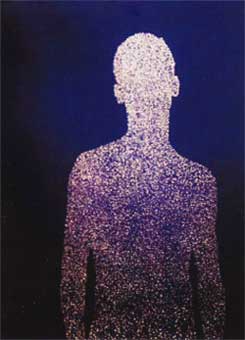25,000 Pinholes: Christopher Bucklow Talks about his “Guest” series
The marketing forces behind digital imaging try to convince us that the latest high-tech equipment is always needed to make first-rate photographs. But consider Christopher Bucklow’s Guest series, which utilizes a low-tech, large-scale pinhole camera to produce images of silhouetted human bodies, which seem to be formed from tiny points of glowing light. They look like what we might see if a Star Trek-like transporter could move a body through time and space.

Each image results from a tin cut-out that Bucklow pierces with up to 25,000 holes in the shape of his subject. This is placed inside a homemade camera over the photographic paper and then exposed to the sun.
Historic connections can be made between Bucklow’s see-through presences and 19th century spirit photographs, which purported to make visual records of persons in a state beyond death. Of course, these ectoplasmic manifestations were really made through double exposure or multiple printing.

And there are similarities between Guest and Olafur Eliasson’s installation, The Weather Project, which dominated the Tate Modern’s Turbine Hall last winter. Both projects share a concern for representing the sun and utilizing light and colour to explore notions about experience, mediation and symbolism. Recently I asked Christopher Bucklow about his work:
Hirsch: How and why did you start making photos?
Bucklow: I started making photographs in 1991 after realizing that the experience offered by the paintings I was making at the time was not sufficiently intense.
Hirsch: What gave you your ideas?
Bucklow: The figures I depict are people I have dreamt about. Mondrian’s early – pre-abstract – paintings were most influential on my photography. I also have a passionate interest in the psychology and evolutionary function of religion. lt is probably close to the views held by the English poet William Blake. Was Blake a Christian? He would have said yes, but one that belonged to a sect numbering precisely one. Would the Pope agree that he was a Christian? No – he would have had him burnt at the stake!
Hirsch: Describe your process of making photographs, how you arrived at it and its relationship to transcending the material limitations of photography.
Bucklow: My pictures are as low-tech as they come: pinhole photography. But I use more than 25,000 pinhole apertures on my cameras and the plate size can be as large as 40 x 100 inches. I shoot directly onto Cibachrome [lfochrome] paper. I only shoot the sun – the paper in the camera becomes the actual work. The thousands of images of the sun’s disc are the only photographic part of my process – the silhouette is basically a drawing.
Hirsch: How do you select your subjects and what do they represent to you?
Bucklow: I believe everyone in your dreams represents a psychological aspect of yourself. So the whole Guest group is offered as an extended self-portrait – females and all.
Hirsch: What is the role of ‘beauty’ in your work?
Bucklow: Beauty thrills me, enthralls me… literally. Therefore it is also deployed as a weapon in the war to cause you to need to look at my work involuntarily.
Hirsch: What does working photography, drawing, painting and video permit you to do, as opposed to sticking with one medium?
Bucklow: Each medium offers another unique range of metaphoric possibilities in my effort to be specific about the subject matter I always explore – always have and always will explore.
Hirsch: Where can people see exhibitions of your work in 2005?
Bucklow: At Hug Gallery in Amsterdam in February and March, at the Huis Marseilles, Amsterdam during the same period, and more generally at the Paul Kasmin Gallery in New York city and the Anthony Wilkinson Gallery in London.
For more infomation, visit : chrisbuklow.com.
![]()
